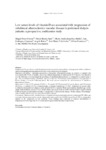Low serum levels of vitamin D are associated with progression of subclinical atherosclerotic vascular disease in peritoneal dialysis patients: a prospective, multicenter study

Ver/
Use este enlace para citar
http://hdl.handle.net/2183/19171Coleccións
- Investigación (FCS) [1293]
Metadatos
Mostrar o rexistro completo do ítemTítulo
Low serum levels of vitamin D are associated with progression of subclinical atherosclerotic vascular disease in peritoneal dialysis patients: a prospective, multicenter studyAutor(es)
Data
2017-02-25Cita bibliográfica
Pérez Fontán M, Borrás Sans M, Bajo Rubio MA, Rodríguez-Carmona A, Betriu A, Valdivielso JM, Fernández E. Low serum levels of vitamin D are associated with progression of subclinical atherosclerotic vascular disease in peritoneal dialysis patients: a prospective, multicenter study. Nephron. 2017;136(2):111-120
Resumo
[Abstract] Background: The prevalence of subclinical atherosclerosis and the main predictors of progression of this condition in patients undergoing peritoneal dialysis (PD) have been insufficiently investigated. Objectives and Method: Following a prospective, multicenter, observational design, we studied 237 patients who were treated with PD for ≥3 months, without any clinical background of cardiovascular (CV) disease. Our objectives were the following: (1) to investigate the prevalence of subclinical atherosclerosis, as compared to a control group of age- and sex-matched healthy individuals, and (2) to disclose PD technique-related predictors of progression of disease during a 24-month follow-up period. We used vascular ultrasound for characterization of subclinical atherosclerotic disease. Main Results: A total of 123 patients (51.9%) vs. 79 controls (33.5%) presented ≥1 carotid plaque, and 114 patients (48.3%) vs. 72 controls (30.5%) ≥1 femoral plaque, at baseline evaluation (p < 0.0005). Progression of disease, either in clinical or ultrasound (new plaques) terms, affected 62.6% of patients. Multivariate analysis identified age, carotid intima-media thickness, presence of ≥1 carotid plaque, and serum levels of 25OH vitamin D and C-reactive protein (CRP) at baseline as independent correlates of progression of atherosclerotic disease. On the contrary, PD technique-related variables did not show any association with this outcome. Conclusions: Atherosclerotic vascular disease is frequent among asymptomatic patients undergoing PD. Older age, pre-existent disease (assessed by vascular ultrasound), and serum levels of 25OH vitamin D and CRP are independent markers of the progression of this condition. These findings may contribute to improve identification of subpopulations with a high risk of CV events, deserving intensified measures of prevention.
Palabras chave
Peritoneal dialysis
Carotid atherosclerosis
Vitamin D
Carotid atherosclerosis
Vitamin D
Versión do editor
ISSN
1660-8151
2235-3186
2235-3186





